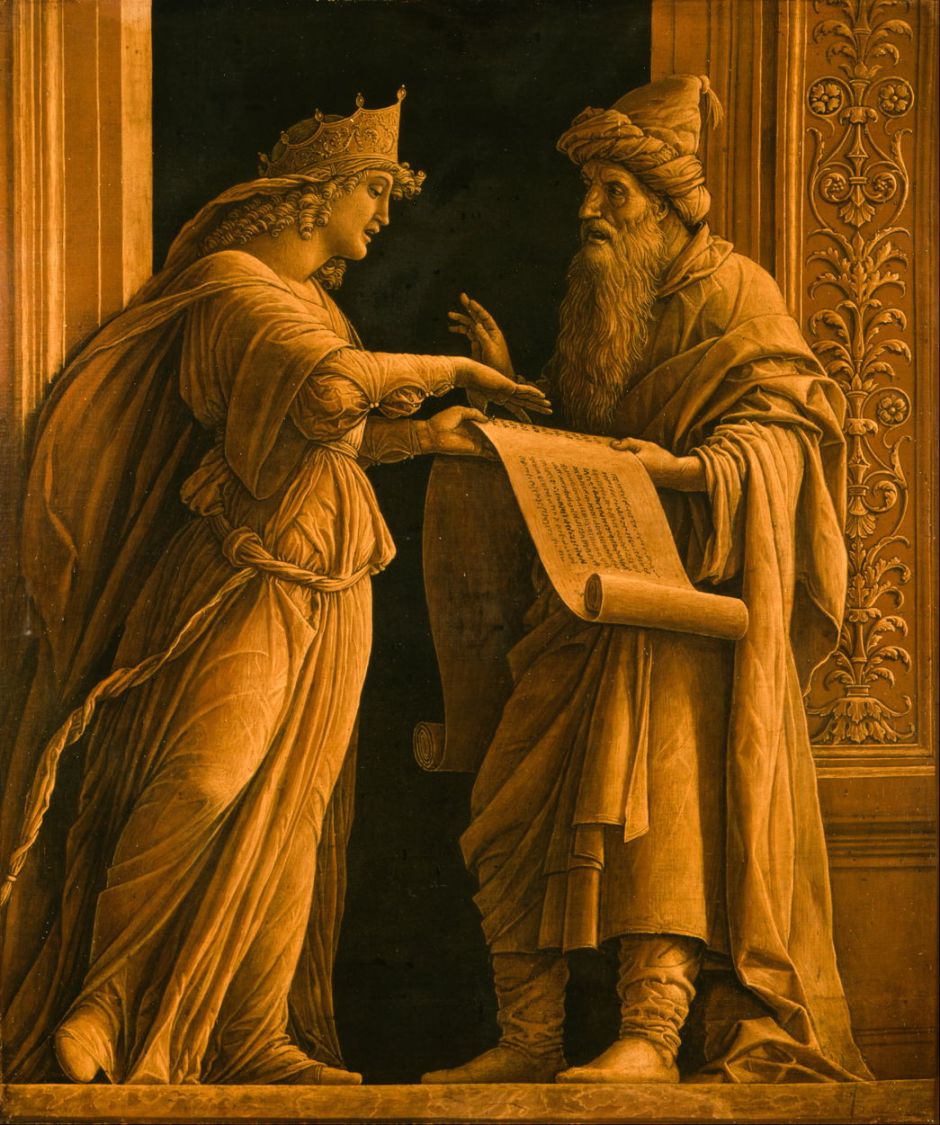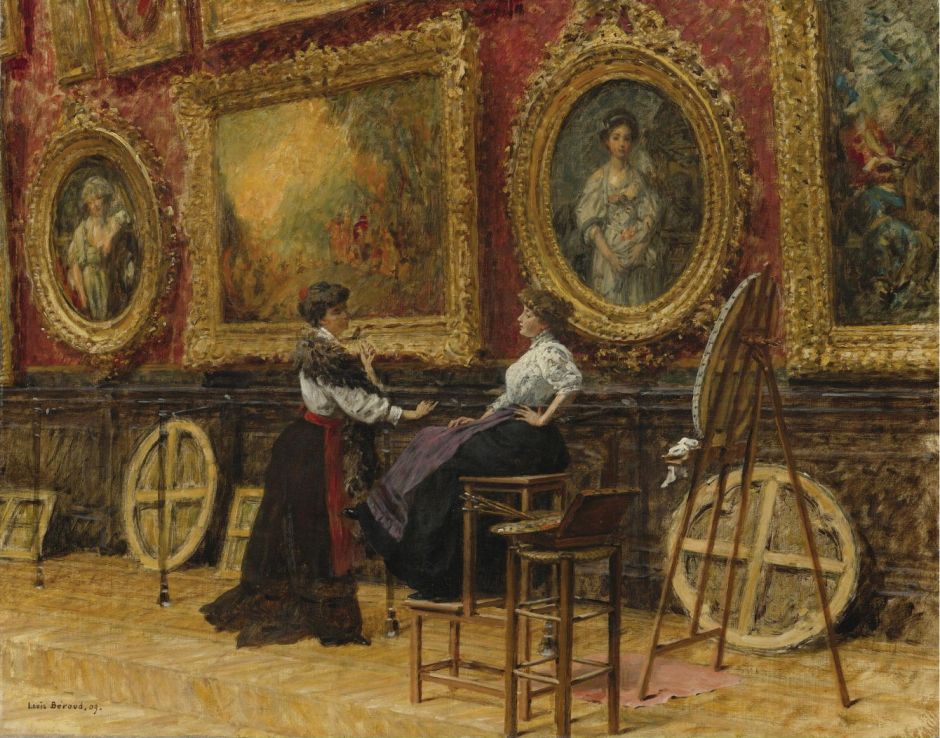Linen and silk have been used as a support for paintings since ancient times, particularly in Egypt and China, where fabrics have been in greatest supply. Their first use in modern European painting seems to have been in the late Middle Ages, when painted banners became popular in churches, and during the fourteenth century artists were painting on fabrics stretched on wooden frames.
The first major proponent of stretched fabrics, which I will refer to generically as ‘canvas’, was Andrea Mantegna (1431–1506), who in the latter half of the fifteenth century painted many works using glue tempera on thin gesso ground applied over fine linen stretched across wooden frames.

Mantegna’s A Sibyl and a Prophet from about 1495 is a good example. In both Northern and Southern centres of the Renaissance, stretched fabrics quickly became popular supports for egg as well as glue tempera. Fabrics have included linen made from flax (also the source of linseed oil, of course), a wide range of grades of cotton, hemp, jute, silk, and most recently synthetic fabrics developed primarily for sailmaking and other purposes.

Just a few years after he had painted Primavera on a large panel, Botticelli switched to stretched canvas for The Birth of Venus (c 1486). As the use of oil paints swept through Italy, canvas became even more popular.
By the early sixteenth century, techniques for painting on canvas were well understood. Fabrics are woven on looms which limit the width of the roll manufactured. Where necessary, because of the size of the work, strips of fabric are stitched together. The resulting sheet is then stretched over a wooden frame, suitably braced to ensure its stability.

This is shown in this view of the back of a canvas in Paul Cézanne’s The Stove in the Studio from about 1865.
Various devices, including jointed ‘stretcher’ frames which could be tensioned by hammering in small wedges, were developed to maintain the fabric in tension, and its edges are tacked (today, stapled) to the wood on the reverse.

The woven fabric then needs to be protected using an isolating layer, originally ‘size’ or ‘rabbit-skin glue’, in reality a glue made from animal products more generally. Over that, chalk-based gesso is applied to form the ground for the oil paint, just as with wood panels.

Canvas proved versatile, and could readily be stretched over circular frames to produce the tondi seen in Louis Béroud’s Copyists in the Louvre (1909), where their cross-braces are apparent. The large painting shown here is Watteau’s Embarkation for Cythera (1717); to the left is Greuze’s The Milkmaid (1780), and to the right his Broken Pitcher (1785).
The technology and technique of painting on stretched canvas developed most actively in Venice. With its many churches and affluent families, there was great demand for substantial paintings. But its maritime environment – cold and wet in winter, hot and humid in summer – made fresco painting far from ideal. Large canvases proved the best solution, and Venetian workshops geared up for their production.

The sixteenth century saw canvases provide the supports for Titian’s greatest paintings, and later for the increasing sizes demanded by Tintoretto – above in an elliptical tondo, and below over sixty square metres (nearly 650 square feet) of paint, in his Crucifixion of 1565. This is about the same size as a squash court.


Veronese’s largest canvas paintings also exceeded 5 x 12 metres (16 x 40 feet) in size, in The Feast in the House of Levi (1573).

One of the largest oil paintings of its time was Tintoretto’s final Paradise, which is a remarkable 7 x 22 metres (23 x 72 feet), only slightly smaller than a tennis court.
Over time, the fabric used in many paintings on canvas deteriorates, and new fabric is attached to the reverse to improve their mechanical stability – a process known as lining or relining. Remarkably, there are still many very old paintings which have never been lined, and continue to look in excellent condition.
Stretched fabrics form a support which is not as rigid and dimensionally stable as wood panels, which makes fine cracking common in the paint layer; ageing fabric is also liable to tear unless of high quality, and is prone to deliberate acts of vandalism. As a result, many valuable oil paintings on canvas are now sadly secured behind protective glass.
Canvas can be detached from its wooden stretchers, sometimes undertaken to prepare a painting for transport or storage in a roll. Although this saved many precious paintings from destruction during the Second World War, rolling painted canvases too tight causes severe cracking in their paint layer, and can require extensive conservation work to minimise the damage. When Théodore Géricault’s massive canvas of The Raft of the Medusa was taken to exhibit in London, it was dismounted, rolled, and shipped in rolled-up form, and some of Rubens’ canvases were transported on the roll between the Netherlands and Spain.
During the heyday of the artist’s workshop, the fabrication of canvas supports and their preparation for use with the application of the ground was largely performed in house. By the nineteenth century, many painters bought in first unprepared canvases made by specialist craftspeople, then prepared canvases with their grounds already laid, ready to paint.

Although Frederic Church’s Heart of the Andes was seen as spectacularly large when he completed it in 1859, by Venetian standards it was small.

Changing painting style allowed some to apply the thinnest of grounds – usually ‘oil grounds’ consisting largely of lead white oil paint – to allow the texture of the underlying fabric to show through in the surface of their finished painting.

Canvases remain popular in plein air and mobile work, but lightweight and more mechanically robust boards began to replace them.
Industrially-manufactured canvases can be of uneven quality, and sometimes have flaws which lead to damage to the paint layer. Many of the paintings of the modern abstract artist Pierre Soulages made during the 1950s have suffered partial or complete delamination of their paint layer, as a result of their manufactured canvases containing water in the ground. This is thought to have occurred as the result of a labour dispute in the factory where they were made.

With the introduction of acrylic paints in the late twentieth century, stretched canvas has remained a popular choice of support. However, acrylic grounds have now largely replaced traditional gesso and oil grounds, even for those painting in oils.

